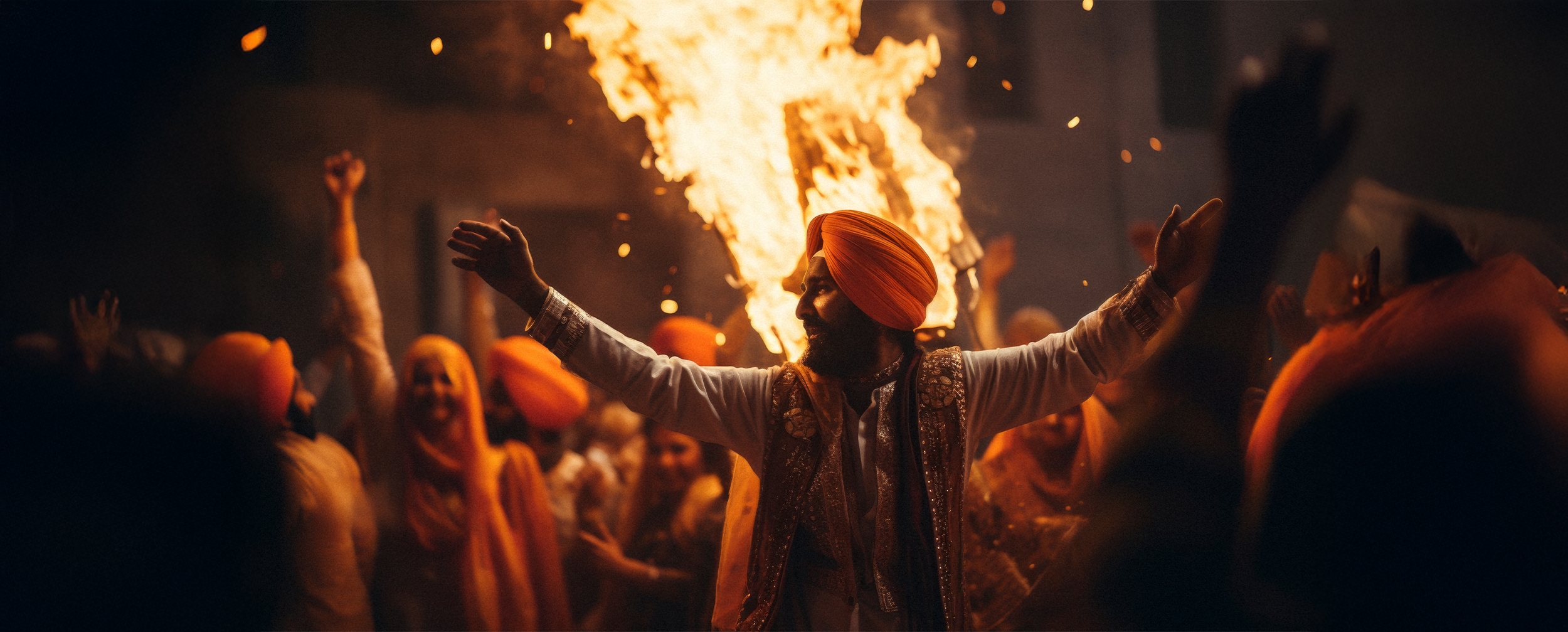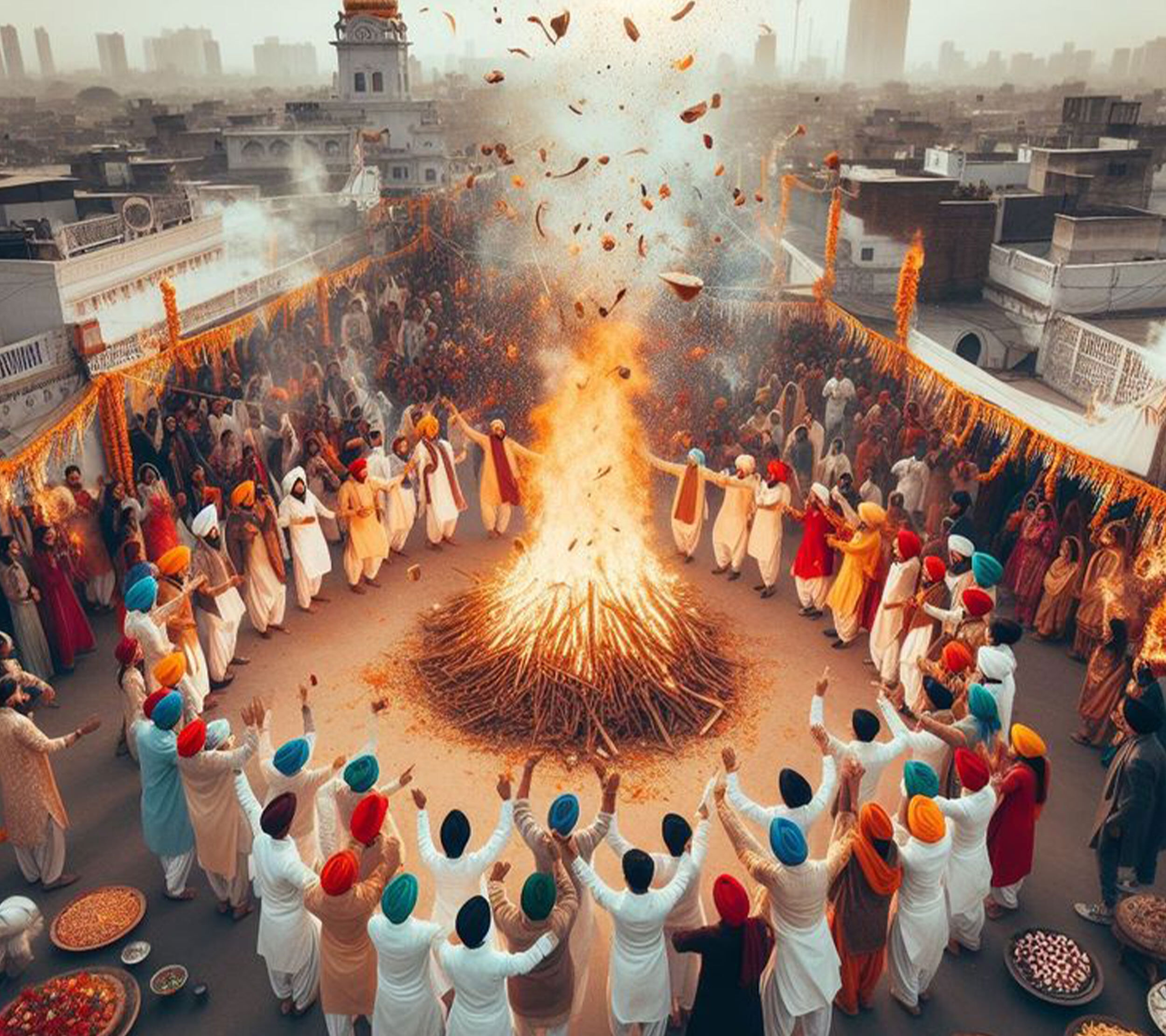STORIES BY DIWAS

Lifestyle
Bonfire, Bhangra & Rewri: Explore Why Do We Celebrate Lohri
Date 10 January 2025 Reading time: 7-10 mins
Punjab's frosty fields stand ready for reaping, and homes come alive with the buzz of festive preparations. It's that cherished time of year again – Lohri is here! As winter's chill begins to yield to spring's gentle warmth, communities across North India eagerly gear up to celebrate this vibrant harvest festival. Bonfires illuminate the evening skies, traditional songs echo through the air, and delicacies like rewri, gajak, and peanuts become staples in every household.
But why do we celebrate Lohri with such zeal and enthusiasm? To answer that, we must delve into the festival's rich history, unique rituals, and profound cultural significance, which continue to unite families and communities in joyful celebration.
Why Do We Celebrate Lohri?
Lohri is a vibrant harvest festival celebrated with joy and enthusiasm, marking the end of the sowing season for Rabi crops and the beginning of the harvest period. It is a time to express gratitude to nature for a bountiful yield, celebrate the hard work of farmers, and come together as a community to welcome prosperity and warmth. To understand in more detail why do we celebrate Lohri, let's look at the history of the festival.
The History of Lohri
Lohri is deeply rooted in gratitude, as farmers thank Agni, the God of Fire, and Surya, the Sun God, for blessing them with a fruitful yield. This joyous occasion falls just a day before Makar Sankranti, symbolizing the sun's northward journey and the start of longer, warmer days.
When wondering why do we celebrate Lohri, the story of Dulla Bhatti often comes to mind. A beloved hero of Punjab, Dulla Bhatti is remembered for rescuing girls from slavery, arranging their marriages, and providing them dowries. Many traditional Lohri songs honour his bravery, emphasising the festival's cultural and historical significance.
Preparation for Lohri
The excitement for Lohri rituals begins days in advance. Markets overflow with seasonal delights like rewri, gajak, peanuts, and popcorn, all staples of the celebration. Bonfires, the centerpiece of the festival, are prepared with wood and cow dung cakes.
- Lohri is also a feast for the eyes, as people dress in colourful traditional attire. Bright, festive wear kurtas for men in hues of yellow, green and red fly off the shelves as people shop for the perfect Lohri outfit. Women adorn themselves in vibrant Punjabi suits and glittering jewellery. From shopping and cleaning to decorating and cooking, every element reflects the joy and togetherness that explains why we celebrate Lohri with such enthusiasm and reverence.
Lohri Rituals
Lohri rituals centre around a bonfire, where people gather to offer puffed rice, popcorn, and rewri, symbolising gratitude and renewal. Traditional Punjabi folk songs and dances like Bhangra and Gidda bring energy to the celebration. Families enjoy festive foods, warmth, and togetherness, marking the harvest season with joy and cultural pride.
The Bonfire Ritual
The bonfire is the heart of Lohri celebrations, symbolising warmth, hope, and renewal. As twilight descends, families and friends gather around the crackling flames, tossing puffed rice, popcorn, and rewri into the fire as offerings to Agni, the fire god. This age-old Lohri ritual represents burning away negativity, inviting positivity, and starting afresh. Couples hoping for the blessing of a child often circle the bonfire, offering prayers for happiness and family harmony.
The sight of people dressed in vibrant, printed kurtas for men and brightly coloured Punjabi suits for women, dancing joyfully around the bonfire, epitomises the festive spirit of Lohri. The warmth of the flames provides comfort during January’s chill, but it’s the sense of community and togetherness that truly fuels the celebration.
The Singing and Dancing Ritual
No Lohri celebration is complete without the rhythmic beats of the dhol and spirited Bhangra moves. Punjabi folk songs narrating the legend of Dulla Bhatti and the coming of spring are sung in lively tunes. Youngsters and elders alike join hands to dance around the bonfire, their colourful dupattas and kurtas swaying to the music. It's a heart-warming sight that captures the essence of Punjab's rich cultural heritage.
These days, many Lohri parties also feature popular Bollywood tracks and remixes. But the traditional favourites like 'Sundar Mundriye' remain evergreen. The catchy lyrics and foot-tapping music create an infectious festive energy that's hard to resist!
Lohri Culture
Why do we celebrate Lohri? It is because Lohri is more than just a harvest festival. It is a celebration of life's milestones. Traditionally, it holds special significance for newlyweds and families with newborns, who are often at the centre of the festivities. These joyous moments are marked by blessings, gifts, and a communal spirit of prosperity and good fortune.
Lohri Attire and Decorations
Lohri is all about celebrating in style! Men flaunt dapper kurtas and jackets in bright festive colours, often with intricate embroidery or print detailing. Diwas offers a range of trendy ethnic ensembles perfect for the occasion. Women drape themselves in vibrant Punjabi suits, lehengas and sarees, accessorized with parandi and jhumkas.
Homes are decked up with marigold garlands, colourful lights and rangoli patterns. The doorways boast 'Good Luck' hangings made of mango leaves and marigolds. Some eco-conscious households are opting for reusable cloth buntings and torans instead of plastic decor. It's heartening to see festivities go green!
Lohri Songs and Music
Songs are an integral part of Lohri culture and Punjab's folk heritage. They narrate tales of valour, celebrate the beauty of the land, and express gratitude for nature's bounty. 'Sunder Mundriye' is a classic that recounts the story of Dulla Bhatti. Other popular tracks include 'Lohri aa gayi, Lohri je dhin' and 'Lal Lal Kurti Pehni'.
In recent years, peppy Lohri pop songs and remixes have gained popularity, especially among the youth. Daler Mehndi's 'Bolo Ta Ra Ra' and Mika Singh's 'Gabru' are party favourites that get everyone grooving. The fusion of traditional and contemporary music adds a fresh flavour to Lohri celebrations.
Traditional Foods of Lohri
Lohri is a foodie's delight! The winter chill calls for indulgent treats like sarson da saag with makke di roti, loaded with homemade white butter. Pinni, a sweet made of ground nuts and jaggery, is a Lohri speciality that provides instant energy. Gajak, til ki barfi, rewri and peanuts are other must-haves.
In Punjab, families bond over the ritual of making festive staples together. The aroma of gur and til wafting through kitchens is a sign that Lohri is just around the corner. These days, many health-conscious folks are experimenting with sugar-free versions of traditional sweets. But the essence remains the same - celebrating abundance and togetherness.
Significance of Lohri in Indian Culture
Why do we celebrate Lohri? Well, now you know! It's a celebration of life, hope and new beginnings that brings communities together, strengthens bonds and keeps traditions alive. The rituals and customs associated with Lohri reflect the deep connection between man and nature, reminding us to cherish the simple joys of life.
As you gear up for Lohri this year, embrace the festive spirit in all its glory. Light a bonfire, sing your heart out, and dig into those delicious treats. Don't forget to check out the stunning kurta collection for men at Diwas to find your perfect festive ensemble. May the warmth of this joyous festival fill your life with happiness, prosperity and new hope. Happy Lohri!


